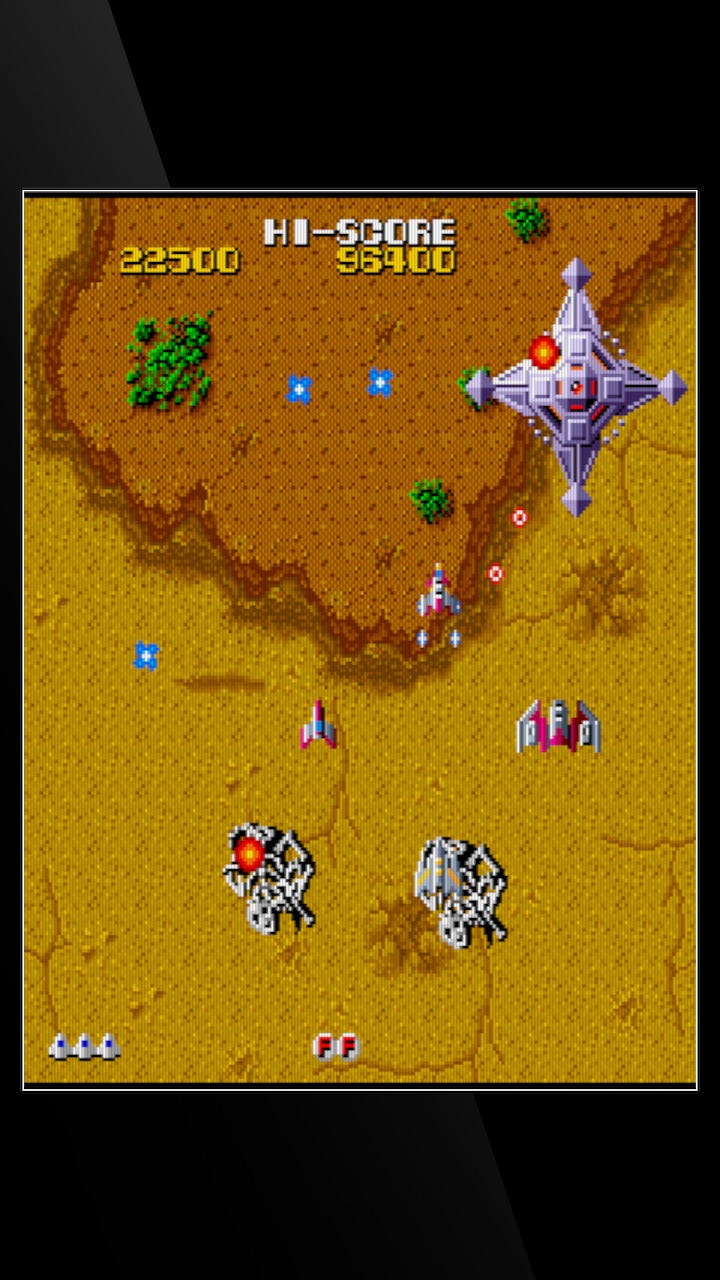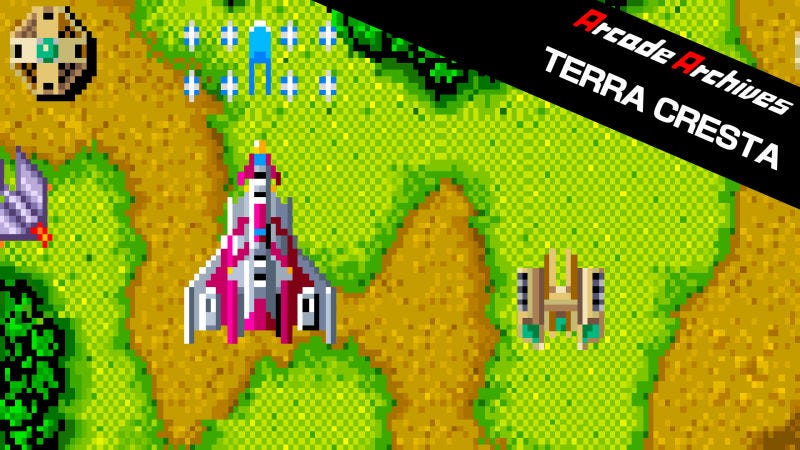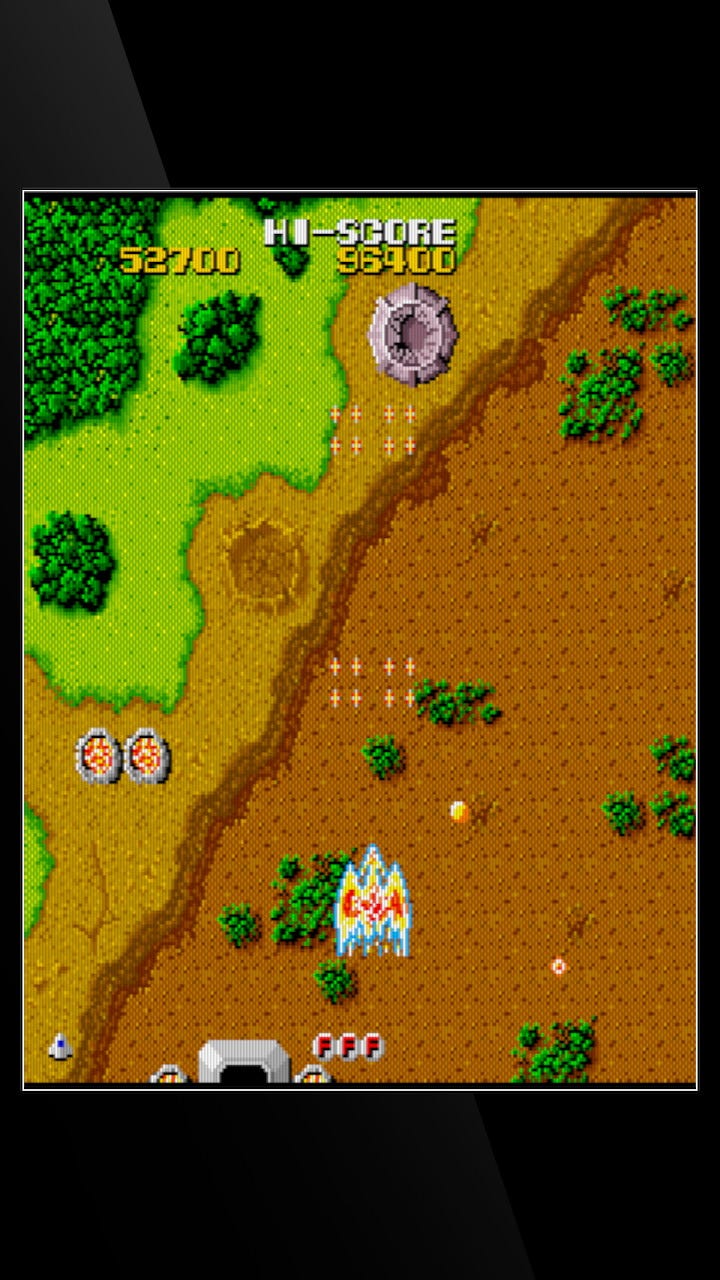Past meets present: Terra Cresta
The Cresta franchise has been dormant for some time, and it looks like its revival will use its oldest, best entries as a jumping off point.
This column is “Past meets present,” the aim of which is to look back at game franchises and games that are in the news and topical again thanks to a sequel, a remaster, a re-release, and so on. Previous entries in this series can be found through this link.
On February 22, 2022, the first game in the Cresta series to release since 1997’s dismal Terra Cresta 3D on the Sega Saturn will hit digital storefronts. While that game (and the demise of its developer and publisher, Nichibitsu) led to the end of the Terra Cresta series for over two decades, the rights have since been picked up by Hamster Corporation, known for their delightful Arcade Archives updates to classics of the platform. And they have PlatinumGames of Bayonetta, NieR: Automata, and Metal Gear Rising: Revengeance fame developing this newest entry, which will be called Sol Cresta, and also represents Platinum’s first foray into what they are themselves calling a “Neo-Classic Arcade” series.
Why should anything be expected to be different this time around? For one, this is Platinum we’re talking about. No one has been a more obvious candidate for a shoot-em-up in the industry than they have been, given their love of high-speed action and twitch-reflex gameplay. Hell, Vanquish was an over-the-shoulder, third-person bullet-hell shooter with time manipulation, like someone converted DoDonPachi from a shoot-em-up into a cover shooter. Doing the real thing felt like an inevitability for Platinum, an inevitability that should happen, and now it is.
And the series they’re going with is one that merits a revival. Yes, the two entries from the 90s were unimpressive, but there are extenuating circumstances for the state of those. Moon Cresta, the original game in the series released in 1980, was designed and programmed by just one person: Shigeki Fujiwara. You absolutely need to be into the Galaxian style of early, fixed shooter arcade games to be into Moon Cresta, as the shooting is slow, the enemies are fast and unpredictable without loads of practice, and death is inevitable because of those two truths, but it’s a great representation of what that slice of the genre was capable of with some tweaks to the formula. More on Moon Cresta in a bit.
The second game, Terra Cresta, was designed by Fujiwara once more, but there was an actual team working on the game this time around. And the results were fantastic: Terra Cresta built on the foundation of Namco’s Xevious like its predecessor had worked off of Namco’s Galaxian, and once again, something that was clearly inspired from others in the genre played very differently than they did thanks to the innovations introduced by Fujiwara and Co.
After Terra Cresta, though, came the spin-off Terra Force, which abandoned the central mechanic of the series that had made its predecessors so enjoyable and suffered for it, and then Fujiwara left Nichibutsu for Hudson Soft, where he would go on to have quite the career contributing in numerous ways — directing, designing, programming, planning, producing, advising, artwork, and even promotion and sales — to a number of excellent Bomberman titles, Battle Lode Runner, Neutopia II, Star Soldier games, DoReMi Fantasy, and even the JRPG series, Tengai Makyо̄, as well as plenty of Hudson’s other offerings through the years.
Fujiwara might have just been one man, but he was one guy who had shown (and continued to show) a real aptitude for the whole game development thing, so losing him to Hudson, when combined with Nichibutsu’s switch to primarily developing erotic mahjong games, left them in a poor position to continue the legacy of Terra Cresta in a way befitting the game’s quality. Considering the care Hamster puts into its Arcade Archive series, and the library Platinum has amassed since 2009, there is plenty of reason to hope that Sol Cresta will succeed where the post-Fujiwara Cresta games failed.
Regardless of whether Sol Cresta is a success either commercially or critically, however, we do have Terra Cresta, and it rules. Let’s start with Moon Cresta, however. It’s a fixed shooter arcade game, as mentioned, which means your ship flies around in the lower portion of the screen while waves of enemies come from above, flying in patterns meant to disrupt your concentration and cause you to miss and/or collide with them. They don’t build up in number like in Galaxian or Galaga before slowly coming down your way one or a few at a time, but instead, the entire wave comes right at you, quickly, and with unpredictable zigging and zagging to throw off your aim and decision making.
“Galaxian, but faster and more unpredictable” is not what set this 1980 shooter apart, however. It was that, after successfully completing a stage, you could dock your tiny little ship with a second ship part, that would make your guns more powerful and cover a wider range, at the expense of your ship’s maneuverability. You move slower, but you’re more powerful — before you get that upgrade, though, you actually have to dock the ships yourself. You can miss your chance to do so, and therefore miss out on more powerful weaponry, which will make continuing along more difficult. Another thing that can limit your power is that rather than outright lives, you have these three ships: if you crash a ship, you move on to the next one. So you can’t actually build your super version of the ship with all three component ships unless you’ve managed to stay alive through multiple levels to dock them all together.

It’s a good game, but the changes Terra Cresta made to the formula five years later make for a far more enjoyable and memorable one. In Terra Cresta, you are free from the fixed shooter style of game, and instead, are in a vertically scrolling shmup. You start with one ship, the Winger, and you do have lives this time around, though, no continues. You still dock with other ships, but instead of it being something that occurs in between levels, it’s a constant, mid-level thing. There are five ship parts in total, the first of which is the Winger, and as you add more, your ship will move and fire differently, and you will also have a different, limited-in-number, and incredibly powerful secondary skill at your disposal, too.
Collect the second ship part, and your ship’s firepower doubles, but also becomes much larger, too. More importantly than all of that, your secondary weapon becomes this huge wave attack that is capable of taking out more difficult enemies with a couple of shots instead of incessant firing of your default weapon that might, might nail you one from a group before the screen scrolls past them. Attach the third ship, and you get cannons on the back of your ship, which is helpful considering there are gun placements behind barriers you can’t shoot through, as well as the occasional wave of enemies that will fly past you and then sneak up from behind. The special attack for this lineup is a triangle formation, with the Winger in the center and back shooting forward, while the other two ships fire diagonally forward. It’s not as powerful as the wave beam, but it catches an even wider area, which can matter more often than you might like. The fourth ship upgrades your front cannon further, giving it a more focused beam that is much more capable at taking down the tougher foes, and the special adds a set of orbs that circle your formation and tears through anything they touch. The fifth and final ship adds a shield to the back of your ship to protect against rear attacks, but more importantly, upon completing this version of the vessel, you get a burst of invulnerability that will let you just crash into any enemy on screen and destroy it. It’s a one-time deal, but you do still have a special formation attack that’s quite formidable, too.
The extra ships are found in closed hangars throughout the game, and you simply have to shoot the security orbs around them, which are helpfully labeled with which kind of ship is inside. Since you can add a ship but then lose it by taking damage — joining with a ship is basically one freebie that will keep you from losing a life but will reduce you to just the Winger — there are times where you might be joining with a ship besides the second one first. While the ship-specific modifications remain intact when this happens — you get the reverse cannon rather than the strong forward gun if you add the simple Winger to the third ship first, for instance — the formation attack is based on the overall number of ships you’ve added to the formation. So 1 + 3 equals 2 as far as formations go, if that makes sense. You can’t have a triangle formation without three ships, you know?
Regardless of how many ships you have at your disposal, if the Winger is hit while you’re in formation mode, you lose. And you will be in formation mode often. Like, whenever possible. You get three formation uses per ship docking, so, be very liberal with your use of them in order to blow up gun displacements, wipe out whole waves of enemy ships in no time, or to blast through the fire-breathing dinosaurs that you’ll see throughout the land. You’ll refill those three uses the next time you dock with another ship, and there is usually one before and after any of the bosses you encounter out there, so don’t worry so much about needing to save up. Just know that using these formations, while allowing you to clear the screen more easily, also opens you up to catching a stray bullet a lot more often, too.
You get an extra life every 20,000 points, which does not sound like all that many points, but your basic enemies give you all of 100 for destroying them. You’ll find, though, that your score climbs much higher much faster the further you get, since waves of enemies worth 300 points each will come at you with ill intent while you’re trying to avoid crashing into projectiles launched by 1,000-point dinosaurs that are flanked by ships that have their own formation attacks that allow them to come at you from two directions at once. It can all fall apart in an instant, sure, but when you’re powered up and feeling it, Terra Cresta is at its best, and the points roll in.
Terra Cresta is a difficult game. It takes a whole bunch of game over screens before you get a sense of how you should be optimizing your formation attacks, how you should be balancing enemies on screen with docking with new ships, what level of aggressiveness is necessary to take on the bosses, which will be extremely aggressive to you even if they are slow-moving, but the thing is that it’s a rewarding kind of difficult. I’ve been slowly watching my scores and place on the online leaderboards climb over my hours with Terra Cresta, and I’ll keep at it even after publishing this. That doesn’t happen with every modern re-release of an arcade classic, you know, but Terra Cresta spoke to me all the way from 1985, and I’m determined to make it even further up the leaderboards.
The main theme you’ll hear as you fly through the world is a great, engaging one that draws you into the intensity of the gameplay. The Arcade Archives version of Terra Cresta game has the sounds and songs for various versions of the game, and you can switch between them, but the originals are the superior offerings. The theme changes just often enough between your deaths and the boss fights that the main theme you hear basically always doesn’t end up grating. It helps that the theme itself is a banger, of course. You don’t even need eight minutes to hear the whole thing game’s soundtrack:
Music has always been a highlight for this series, to the point that Hardcore Gaming 101’s Jess Ragan wrote of Terra Cresta 3D that, “If the enthusiasm and creativity that went into the music had seeped into the rest of the game, Nichibutsu might have had something special.” There’s a reason that Yuzo Koshiro of Ys, ActRaiser, Etrian Odyssey, and Streets of Rage 2 fame composed Sol Cresta for Platinum, and it’s because the legacy of the series’ music needed to be upheld.
Terra Cresta received a number of releases in its original day, with arcades being its first home followed by ports to the NES, Commodore 64, ZX Spectrum, X68000, and even the Playstation 2, well after the fact. Now, though, you can play the Arcade Archives version on the Playstation 4 and Nintendo Switch, and you should. It comes with display options so you can play in TATE mode as God intended, there are adjustable scanline screen filters that help the 1985 pixelated artwork shine, and the online leaderboards really do add something to the experience. It’s just $7.99, like all the Arcade Archives releases, and comes with a concept that, until Sol Cresta arrives with its modified version of it, still feels pretty unique and engaging decades after its release.
This newsletter is free for anyone to read, but if you’d like to support my ability to continue writing, you can become a Patreon supporter, or donate to my Ko-fi to fund future game coverage at Retro XP.






